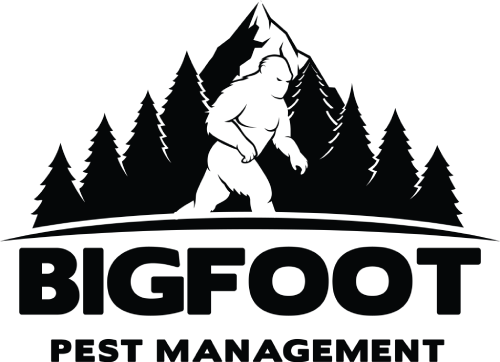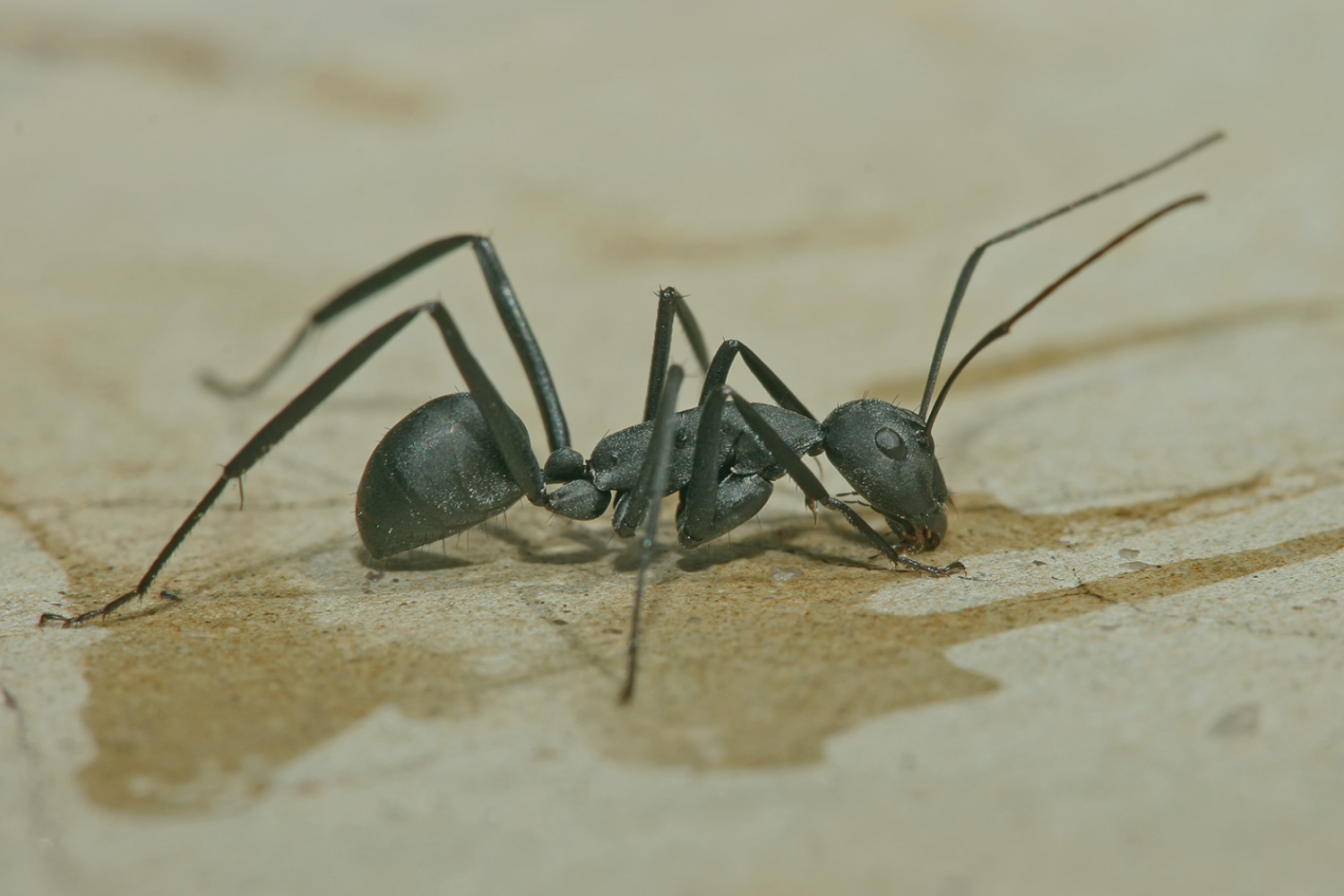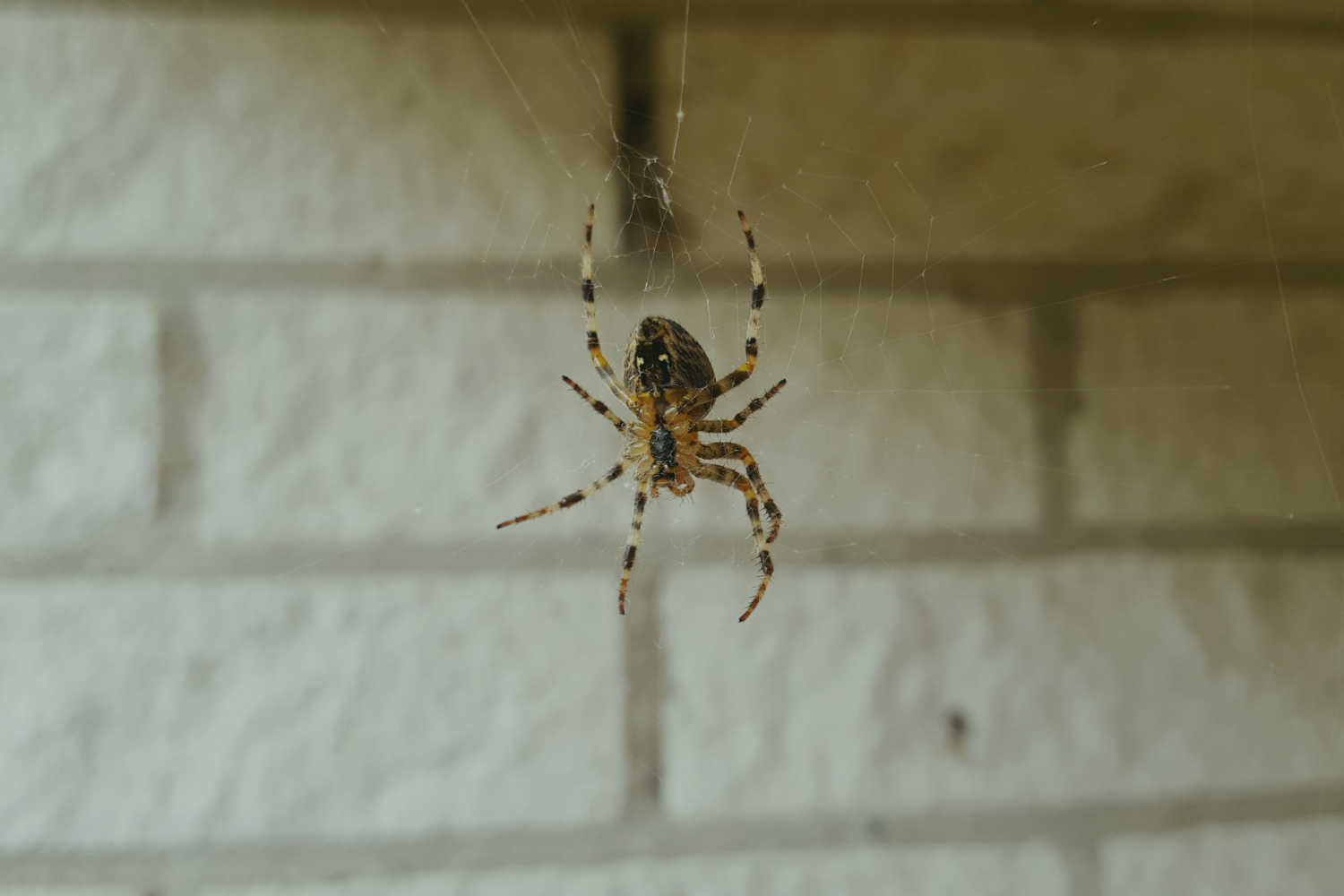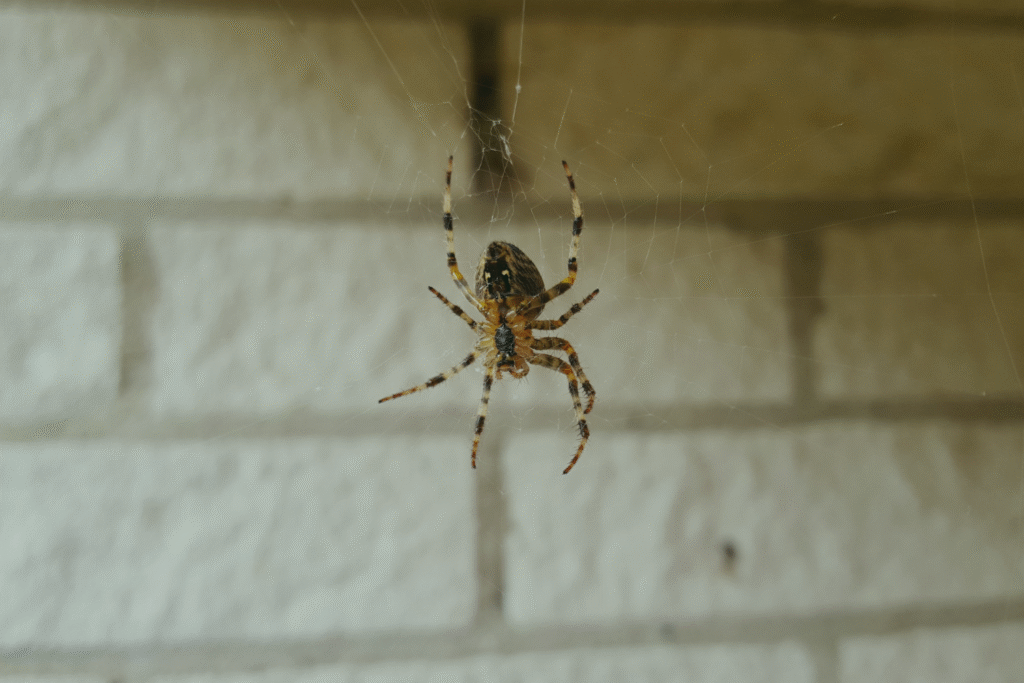
If you live in Olympia or the surrounding South Puget Sound area, you have probably seen a big house spider at least once inside your home.
These spiders move quickly, grow large, and often appear during late summer and fall when the weather changes and insects head indoors. Their size can be alarming, but most big house spiders are harmless and even helpful.
This guide explains what big house spiders are, what they look like, why they enter homes in the Pacific Northwest, and how to keep them under control. It also covers other common house spiders in Olympia, how Bigfoot Pest Management identifies spider problems, and when to call a professional.
Why Are Big House Spiders So Common in Washington Homes?
A big house spider is a large, fast-moving spider that often lives in and around homes in the Pacific Northwest. The species most common in Olympia are from the Eratigena atrica group, sometimes called the giant house spider. These spiders are impressive in size but not harmful.
Big house spiders show up frequently in Washington homes because the region’s cool, wet climate creates the perfect environment for both spiders and the insects they feed on.
Olympia and the surrounding areas have abundant moisture, forest cover, and shaded structures, all of which support high insect populations. When insects thrive, spiders do too.
Big house spiders naturally live around homes, hiding in garages, basements, crawl spaces, and storage areas where it’s dark and undisturbed. They often wander indoors while searching for food or when outdoor temperatures shift.
Their long legs, fast movement, and larger size make them especially noticeable when they appear inside.
While their appearance can be startling, these spiders prefer to avoid contact with people. They aren’t entering your home to seek you out; they’re simply following prey or looking for shelter from Washington’s changing weather.
How Should You Address a Big House Spider in Your Home?
Big house spiders are some of the largest spiders found in Washington homes. This makes them easy to identify once you know what to look for.
Key identification features include:
- Leg span that can reach 1.5 to 2.5 inches
- Body length up to 0.75 inches
- Long, thin legs that stretch outward
- Brown, tan, or dark brown coloring
- Subtle markings on the abdomen
- Very fast running speed
If you spot a big house spider, the best approach is to focus on why it’s there rather than the spider itself. These spiders usually indicate that insects, moisture, or entry points around the home are providing them with easy access and a good reason to stay.
Start by checking common areas where spiders are likely to be found, such as basements, garages, crawl spaces, corners near the ceiling, and areas under stored items. These locations often provide the humidity, darkness, and insect activity that spiders prefer.
While identifying the spider can help confirm it’s harmless, addressing the conditions that attracted it will make a bigger impact.
Reducing moisture, sealing gaps under doors or around screens, and controlling indoor insects are effective steps to discourage future sightings.
Since big house spiders move quickly and have long, thin legs that stretch outward, homeowners often notice them before other species, but managing the environment is the key to keeping them out.
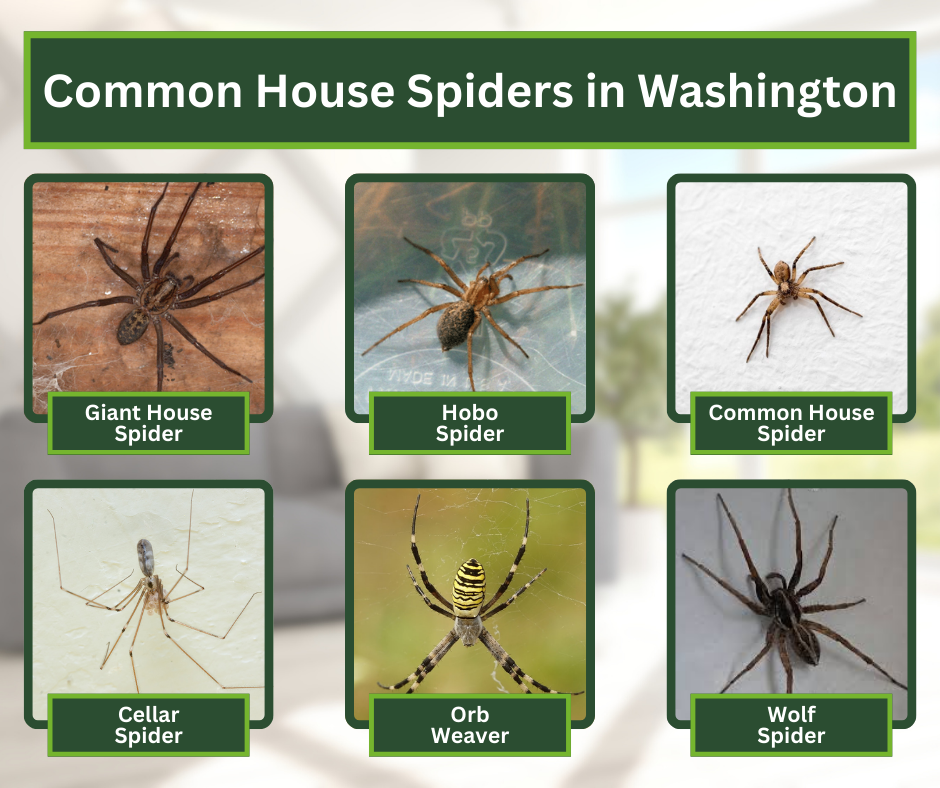
Common House Spiders in Washington
Olympia’s cool, wet climate supports many spider species. Knowing the difference helps homeowners understand which spiders are harmful and which are harmless.
1. Giant House Spider
- The most common big house spider in the area
- Large body and long legs
- Fast runner
- Builds messy sheet-like webs
- Harmless and helpful
2. Hobo Spider
- Often confused with big house spiders
- Medium size with chevron markings
- Prefers low corners and floor-level hiding spots
- Not considered medically dangerous
3. Common House Spider (American House Spider)
- Found in corners and around windows
- Creates cobweb-style webs
- Small and harmless
4. Cellar Spider (Daddy Longlegs Spider)
- Very long, thin legs
- Small body
- Lives in basements, garages, and crawl spaces
- Not harmful
5. Orb Weaver
- Large, round abdomen
- Builds circular webs outdoors
- Common near porches and gardens
- Beneficial for controlling insects
6. Wolf Spider
- Fast runner
- Thick body
- Hunts insects on the ground
- Prefers crawl spaces and basements
- Rarely bites unless handled
These species are found year-round, especially in neighborhoods surrounded by forested areas, wetlands, parks, or greenbelts.

Why Big House Spiders Enter Olympia Homes
Big house spiders do not enter homes to seek out people. They come inside for three main reasons: food, shelter, and climate.
1. They follow other insects
Spiders eat flies, ants, mosquitoes, beetles, silverfish, moths, and other spiders. If these insects are inside your home, a big house spider may follow.
2. Seasonal weather changes push them indoors
Olympia has cool nights, rainy weather, and shifting moisture levels. When temperatures drop or humidity increases, spiders and insects move inside for warmth and shelter.
3. Homes have easy entry points
Spiders enter through:
- Gaps under doors
- Crawl space vents
- Loose window screens
- Gaps around pipes
- Cracks in siding
- Garage door seals
4. Crawl space moisture creates an ideal habitat
Many homes in Olympia sit over moist crawl spaces, which attract insects and spiders. A damp crawl space is one of the biggest reasons spiders show up indoors.
Are Big House Spiders Dangerous?
No. Big house spiders are not dangerous. However, here’s what homeowners should know:
1. They rarely bite
House spiders only bite if trapped or pressed against skin. They prefer to run away.
2. Their venom is not harmful
If a bite happens, the symptoms are minor. This includes redness, itching, and swelling.
3. They help reduce pests
They eat many common household insects, which helps prevent infestations. This includes pests like cockroaches, mosquitoes, moths, and ants.
4. They do not spread disease
Spiders do not transmit illnesses as some insects do.
Despite their harmless nature, having many spiders indoors can be overwhelming and usually means other pests are present.
Why Do You See More Big House Spiders in Late Summer and Fall?
Fall is peak spider season in Olympia, Washington, and the surrounding areas. Homeowners report more sightings between August and October.
Reasons include:
- Mating season
- Temperature changes
- Shorter days
- Increased indoor insect activity
- Cooler nights are pushing spiders indoors
- Moisture changes in crawl spaces and basements
In particular, homes near wooded areas, trails, or water see even more spiders during this period.
How Bigfoot Pest Management Inspects for Big House Spider Issues
A spider problem almost always has an underlying cause. Bigfoot Pest Management uses a detailed inspection process to find what is attracting spiders and where they are entering your home.
1. Exterior Inspection
Technicians check:
- Gaps around doors
- Damaged weather stripping
- Loose window screens
- Siding cracks
- Crawl space vents
- Exterior lighting
- Vegetation touching the home
Most spider entry points are small but easily fixable.
2. Crawlspace and Basement Inspection
This is one of the most important parts of the inspection.
Crawlspaces in the Pacific Northwest often have:
- High humidity
- Condensation
- Standing water
- Mold growth
- Bugs like ants, silverfish, or beetles
- Rodent droppings
- Organic debris
These conditions attract insects, which then attract spiders.
3. Spider Species Identification
Identifying the correct species helps determine:
- Whether you have a harmful spider
- Where the spiders are breeding
- What type of treatment is needed
Many homeowners misidentify harmless house spiders as hobo spiders or wolf spiders. Professional identification removes the guesswork.
4. Checking for Other Pests
A spider problem is often a sign of another pest issue. Bigfoot techs check for:
- Ants
- Moisture ants
- Silverfish
- Beetles
- Earwigs
- Moths
- Flies
- Wasps
If insects are present, spiders may stick around.
5. Moisture Evaluation
Olympia’s wet climate means moisture is one of the top causes of indoor pests.
Technicians use:
- Moisture meters
- Crawl space evaluations
- Insulation checks
- Ventilation checks
- Leak inspections
Managing moisture is one of the best long-term solutions for spider control.
How to Keep Big House Spiders Out of Your Home
Here is a simple guide to the most effective prevention steps:
|
Prevention Method |
Why It Helps |
Where to Focus in Olympia Homes |
|
Seal entry points |
Stops spiders from getting inside |
Doors, windows, siding gaps, and crawlspace vents |
|
Reduce indoor insect activity |
Removes the spider’s food source |
Kitchens, bathrooms, basements, crawlspaces |
|
Manage moisture |
Damp areas attract insects and spiders |
Crawlspaces, bathrooms, laundry rooms |
|
Clean and declutter |
Removes hiding spots spiders love |
Garages, basements, storage rooms |
|
Reduce outdoor lighting |
Light attracts insects at night |
Porches, entryways, garages |
|
Use door sweeps and weather stripping |
Prevents spiders from slipping under doors |
Front doors, garage doors, patio doors |
|
Maintain vegetation |
Keeps spiders from nesting near the home |
Bushes, vines, shrubs, wood piles |
This table covers the strongest and most reliable prevention steps for Olympia homeowners.
When DIY Prevention Is Not Enough
Even when homes are clean and sealed, spiders can still enter because of:
- Nearby forests
- Wet weather
- Crawl space moisture
- Nearby standing water
- High insect activity outdoors
Call a professional when:
- You see spiders every day
- Spiders show up in bedrooms or living spaces
- Webs appear shortly after cleaning
- Your crawl space has moisture or insect problems
- You are not sure what species you are seeing
Treatment Options from Bigfoot Pest Management
Bigfoot Pest Management uses targeted methods designed for Washington’s climate.
1. Perimeter Treatment
This treatment stops spiders before they enter.
2. Crawl Space Treatment
This controls insects and spiders at their source.
3. Crack and Crevice Interior Treatment
This targets hidden spiders and egg sacs.
4. Web Removal and Monitoring
This prevents spiders from rebuilding nesting areas.
5. Moisture Control Solutions
Controlling moisture reduces humidity, which attracts insects and spiders.
6. Follow-up Monitoring
This ensures spiders do not return.
Related Questions
Do big house spiders crawl into beds?
Very rarely. Spiders stay low and near walls.
Do they come inside in groups?
No. If you see several, it is because Washington’s damp and humid environment is attracting them.
Do they harm pets?
No. Spiders are not dangerous to cats or dogs.
When to Call a Professional
Call Bigfoot Pest Management if:
- You see multiple big house spiders regularly
- Your crawlspace has humidity issues
- Insects are active indoors
- Webs reappear quickly
- Spiders show up in bedrooms or main living areas
A professional inspection will identify the source and build a prevention plan that works for your home.
Conclusion
Big house spiders are common in Olympia, but you do not have to live with them inside your home. With proper pest control, moisture management, and prevention, you can enjoy a cleaner and more comfortable home year-round.
Whether you are dealing with spiders in your crawl space, basement, garage, or living areas, Bigfoot Pest Management has the tools and expertise to help.
Schedule your spider inspection or treatment today and keep your home spider-free.
What Do Carpenter Ants Look Like in Washington Homes?
When homeowners ask what do carpenter ants look like in Washington homes, the answer is simple. Carpenter ants are large black or dark red ants…
Read MoreBig House Spider? Save These Pro Identification and Control Tips
If you live in Olympia or the surrounding South Puget Sound area, you have probably seen a big house spider at least once inside your…
Read More